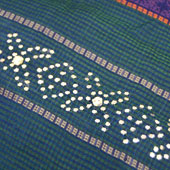Design Resource
Mukaish Work of Lucknow
Embroidery with Metallic Wires
by
In older times, clothes for the royalty were embroidered with silver wires. This got replaced by cheaper metals. Any metal is first stretched into strips that are passed through flames for different colors and cut in fine wires. These are then beaten with a tiny hammer for hours to produce a thin, papery density that can be used to embroider on the fabric.
There are two types of Mukaish work namely Fardi Ka Kaam and Kamdani.
• Fardi Ka Kaam:
Fardi, literally meaning dots, is the most basic yet beautiful type of Mukaish work. Dots are stitched in different sizes and patterns. The ‘hazaar batti’, thousand dots design in Fardi is characteristic of Lucknow. ‘Tikki’ (flat sequins) and ‘challa’ (rings) are used extensively to enhance the design. Size of the dot depends on the width of the wire used and is referred to as numbers - point 4 being the larger dot, point 2 smaller, point 1 being the smallest and most expensive dot. Fardi ka kaam is usually done by women from their homes.
• Kamdani:
In Kamdani, the wire attached to a small length of thread is pulled through the fabric with a needle, beautifully working into motifs. This is also referred to as ‘fancy kaam’. Kamdani is fast becoming a rarity and most of the craftsmen are elderly men.














































